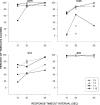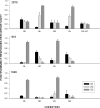Discriminated timeout avoidance in pigeons: the roles of added stimuli
- PMID: 17725051
- PMCID: PMC1918084
- DOI: 10.1901/jeab.2007.59-06
Discriminated timeout avoidance in pigeons: the roles of added stimuli
Abstract
Two experiments examined pigeons' postponement of a signaled extinction period, or timeout (TO), from an ongoing schedule of response-dependent food delivery. A concurrent-operant procedure was used in which responses on one (food) key produced food according to a variable-interval schedule and responses on a second (postponement) key delayed the next scheduled TO according to a response-TO (R-TO) interval. A series of response-independent stimulus changes on the food key temporally partitioned the R-TO into three equal segments (S1, S2, and S3). Postponement responses, in addition to postponing TO, also reinstated S1, the stimulus correlated with the greatest temporal distance from TO. In Experiment 1, the R-TO interval was manipulated systematically across blocks of sessions (conditions) at a given ratio of R-TO:TO duration. This R-TO:TO ratio was manipulated across blocks of conditions (phases). Postponement response rates varied inversely with R-TO interval in each phase. Changes in the R-TO:TO ratio did not produce consistent differences except at the 1:10 ratio for some pigeons, where it disrupted postponement responding in some conditions. Most of the postponement responses occurred in the presence of S2 and S3, the stimuli most proximal to TO, whereas most of the food-key responses occurred in S1. In Experiment 2, the R-TO contingencies were systematically manipulated in the presence of the time-correlated stimuli. In one set of conditions, the R-TO contingencies were made either ineffective or less effective in the presence of one or more stimuli. Postponement responses typically shifted to stimuli in the presence of which responses were relatively more effective. Postponement responses decreased markedly when the added stimuli were removed, and then recovered when the stimuli were reinstated. Results from both experiments indicate that the added stimuli in a discriminated TO-avoidance procedure serve predominately discriminative functions, delineating periods during which behavior is maximally effective. The results parallel those obtained in shock-avoidance procedures, providing further evidence that TO functions as an aversive stimulus.
Figures






Similar articles
-
Timeout postponement without increased reinforcement frequency.J Exp Anal Behav. 2000 Sep;74(2):147-64. doi: 10.1901/jeab.2000.74-147. J Exp Anal Behav. 2000. PMID: 11029020 Free PMC article.
-
Variable-interval schedules of timeout from avoidance.J Exp Anal Behav. 1987 Jan;47(1):97-113. doi: 10.1901/jeab.1987.47-97. J Exp Anal Behav. 1987. PMID: 16812473 Free PMC article.
-
Stimulus-food relations and free-operant postponement of timeout from response-independent food presentation.J Exp Anal Behav. 1983 Sep;40(2):153-63. doi: 10.1901/jeab.1983.40-153. J Exp Anal Behav. 1983. PMID: 16812340 Free PMC article.
-
The role of discriminative stimuli in modulating drug action.Fed Proc. 1975 Aug;34(9):1880-8. Fed Proc. 1975. PMID: 1097270 Review.
-
The midsession reversal task: A theoretical analysis.Learn Behav. 2020 Jun;48(2):195-207. doi: 10.3758/s13420-020-00423-8. Learn Behav. 2020. PMID: 32342285 Review.
Cited by
-
On distinguishing progressively increasing response requirements for reinforcement.Behav Anal. 2010 Spring;33(1):119-25. doi: 10.1007/BF03392207. Behav Anal. 2010. PMID: 22479130 Free PMC article.
-
Avian Emotions: Comparative Perspectives on Fear and Frustration.Front Psychol. 2019 Jan 17;9:2707. doi: 10.3389/fpsyg.2018.02707. eCollection 2018. Front Psychol. 2019. PMID: 30705652 Free PMC article. Review.
References
-
- Baron A. Avoidance and punishment. In: Iversen I, Lattal K, editors. Experimental analysis of behavior, part 1. New York: Elsevier Science; 1991. pp. 173–217.
-
- Boren J.J, Sidman M, Herrnstein R.J. Avoidance, escape, and extinction as functions of shock intensity. Journal of Comparative & Physiological Psychology. 1959;52:420–425. - PubMed
-
- Ferster C.B. Control of behavior in chimpanzees and pigeons by time-out from positive reinforcement. Psychological Monographs. 1958;72:38.
Publication types
MeSH terms
LinkOut - more resources
Full Text Sources

